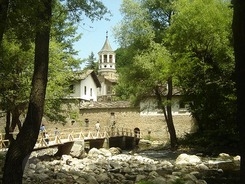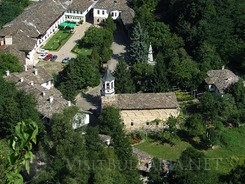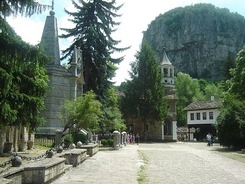Over one billion euro has been invested in the wellness and spa industry in Bulgaria over the past more...
| Search | Hotels / Accommodation | Vacations | Tours & Trips | Rent A Car | Transport | Flights | Conferences | Press Centre | Yachting |
- Hotels & Accommodation in Dryanovo



- Casa Volley Hotel
- Park Hotel Dryanovo
- Dryanovo Guide
- Early booking in Dryanovo
- All inclusive in Dryanovo
- Last minute in Dryanovo
- Hotels in Dryanovo
- Apartments in Dryanovo
- Villas in Dryanovo
- Rural houses in Dryanovo
- Vacations in Dryanovo
- Transport To Dryanovo
- Tours in Dryanovo
- Conferences in Dryanovo
- Articles on Dryanovo
- News From Dryanovo
- Dryanovo Monastery
- Holidays in Bulgaria
- All inclusive
- Beach
- Birdwatching
- Golf
- Health
- History
- Hunting
- Monasteries/ Religious
- Mountain biking
- Prom
- Rural
- Ski
- Spa & Wellness
- Trekking
- Water sports
- Weekend breaks
- Wine
- Conference
- Children Holidays
- Yachting
- Events
- Type of accommodation
- Hotels
- Apartments
- Villas
- Rural houses
- Destinations
- Aheloy
- Ahtopol
- Albena
- Apriltsi
- Arbanassi
- Asparuhovo
- Assenovgrad
- Bachkovo Monastery
- Balchik
- Bankya
- Bansko
- Banya (Karlovo)
- Banya (Razlog)
- Batak
- Beklemeto
- Belchin Bani
- Beli Iskar
- Belogradchik
- Berkovitsa
- Blagoevgrad
- Bodrost
- Bojichen
- Borovets
- Botevgrad
- Bourgas
- Bozhentsi
- Bratsigovo
- Brestovitsa
- Buzludja
- Byala
- Chepelare
- Cherepish Monastery
- Chernomorets
- Chiflik
- Devin
- Dimitrovgrad
- Dobarsko
- Dobrich
- Dobrinishte
- Dolna Banya
- Dospat
- Dryanovo
- Dupnitsa
- Dyuni
- Elena
- Elenite
- Elhovo
- Gabrovo
- Gela
- Golden Sands
- Gorna Oryahovitsa
- Gotse Delchev
- Govedartsi
- Grand Hotel Varna
- Harmanli
- Haskovo
- Haskovo Mineral Baths
- Hissarya
- Ivaylovgrad
- Kalofer
- Kamchia
- Kamen Bryag
- Kardjali
- Karlovo
- Kavarna
- Kazanlak
- Kiten
- Kom
- Koprivshtitsa
- Kosharitsa
- Kostenets
- Kostenkovtsi
- Kotel
- Kovatchevitsa
- Kranevo
- Kresna
- Kulinoto
- Kyustendil
- Lom
- Lovech
- Lozenets
- Lukovit
- Lyaskovets
- Madara
- Malko Tarnovo
- Malyovitsa
- Melnik
- Mezdra
- Momchilovtsi
- Montana
- Narechen Baths
- Near Golden Sands
- Nessebar
- Obzor
- Ognyanovo
- Osogovo
- Pamporovo
- Panagyurishte
- Panichishte
- Parshevitsa
- Pavel Banya
- Pavlikeni
- Pazardjik
- Pernik
- Petrich
- Pirdop
- Pleven
- Pliska
- Plovdiv
- Pomorie
- Pravets
- Preslav
- Primorsko
- Ravda
- Razgrad
- Razlog
- Ribaritsa
- Rila Monastery
- Riviera
- Rousse
- Rusalka
- Samokov
- Sandanski
- Sapareva Banya
- Semkovo
- Sevlievo
- Shabla
- Shipka
- Shipkovo
- Shiroka Laka
- Shkorpilovtsi
- Shoumen
- Silistra
- Sinemorets
- Sliven
- Smolyan
- Sofia
- Sopot
- Sozopol
- Srebarna
- St. Constantine & Elena
- Stara Zagora
- Starozagorski Baths
- Sunny Beach
- Sunny Day
- Sveti Vlas
- Svilengrad
- Svishtov
- Targovishte
- Teteven
- Tran
- Trigrad
- Troyan
- Tryavna
- Tsarevo
- Tsigov Chark
- Uzana
- Varna
- Varshets
- Veliko Tarnovo
- Velingrad
- Vidin
- Vitosha
- Voneshta Voda
- Vratsa
- Vratsata Gorge
- Yagoda
- Yakoruda
- Yambol
- Zlatitsa
- Zlatograd
- Bulgaria Guide
- General information
- Bulgarian Monasteries
- SPA Bulgaria
- The Black sea
- History
- Geography
- Maps
- Weather
- Airports in Bulgaria
- Webcams
- Forums
- Mountains in Bulgaria
- The Balkan Mountain Range
- Rila Mountain
- Pirin Mountain
- The Rodope Mountain
- Vitosha Mountain
- Travel Arrangements
- Visit Bulgaria
- Visa Requierments
- Choose Destination
- Flights to Bulgaria
- Transport in Bulgaria
- Advice
- Currency
- Official Holidays
Subscribe to newsletters to receive our hottest offers:
Dryanovo Monastery

Location: St. Archangel Michail Dryanovo monastery is huddled in the picturesque gorge of Dryanovo river in Stara Planina Mountain. It is about 5 km away from Dryanovo, 15 km away from the town of Gabrovo and about 220 km away from Sofia. The monastery is easy to reach by car, driving down the main road from the town of Veliko Turnovo to Gabrovo.
The monastery is surrounded by picturesque mountain walls, high limestone rocks, caves and a great variety of flora and fauna.
History: The monastery has an ancient history. The first traces of life date back to the pre historical epochs when people lived in the caves surrounding the monastery. The earliest artifacts proving the existence of human life were found in Bacho Kiro cave and date back to the second half of the Old Stone epoch (100 000 – 10 000 years b.c). There are more than 6000 archeological findings.
During the Early Byzantine epoch the strategic importance of the mountain region increased. The Byzantines built two fortresses near the rivers in the areas “Boruna” and “Grada” in the middle part of Stara Planina mountain. In the 5th century they left the fortresses when the region was settled by the Slavic tribes. The two fortresses defended the old Bulgarian capital Tarnovo.
 St. Archangel Michail Dryanovo monastery dates back to the time of reign of the Assen dynasty, the Second Bulgarian Kingdom, the 12th century. It was built in relation to the celebration of the victory of Bulgaria over Byzantium in 1187. During the centuries it became one of the centers of Bulgarian culture and literature.
St. Archangel Michail Dryanovo monastery dates back to the time of reign of the Assen dynasty, the Second Bulgarian Kingdom, the 12th century. It was built in relation to the celebration of the victory of Bulgaria over Byzantium in 1187. During the centuries it became one of the centers of Bulgarian culture and literature.
During the Ottoman rule Dryanovo monastery is one of the main symbols of the insubordinate Bulgarian spirit and struggle for the liberation. One of the main quarters of the Bulgarian Central Revolutionary Committee in Turnovo was located exactly in the monastery and famous rebel leaders such as Vassil Levski and his adherents were often to be found there.
The monastery played important role in the April uprising. When the uprising burst out in 1876, 200 revolutionaries led by Pop Hariton, Lieutenant Peter Parmakov and Daskal (teacher) Bacho Kiro defended the unassailable fortress for 9 days. But the numerous Turkish army shattered the outbreak of the brave rebellions. The monastery was burned and destroyed.
 About the monastery: The monastery was rebuilt in 1880. A new residential part and a museum were added to the existing buildings. The bell-tower was erected in 1925.
About the monastery: The monastery was rebuilt in 1880. A new residential part and a museum were added to the existing buildings. The bell-tower was erected in 1925.
The church is without wall-paintings and the holes from the shells of the turks were left in the stonewalls and the museum collection tells us about the epic battles
At present, the friary is operating. The contemporary monastery is one of the 10th most honored cloisters of the Bulgarian Orthodox church. It is national historic monument and one of the most visited tourist destinations. The monastery offers accommodation and food.
Caves and rock climbing:
The Bacho Kiro Cave (Dryanovo Cave) is located near the monastery. The cave is electrified and open for visitors. The cave has waterfall, interesting formations and karst spring.
Andaka Cave: length - 4,5 km; horizontal, water cave;
Caves near the village of Varpishta. The caves are with different length, horizontal, dry.
Izvora (Spring) Cave: length – 4 km; horizontal, water cave. It is situated near the Yantra river.
Rock climbing: Rocks with height from 5 to 80 m near the Dryanovo monastery are suitable for climbing.
Hiking:
- Dryanovo eco trail;
- “Via Ferrata” eco trail;
- Different hiking tours can be organized in the region.

















